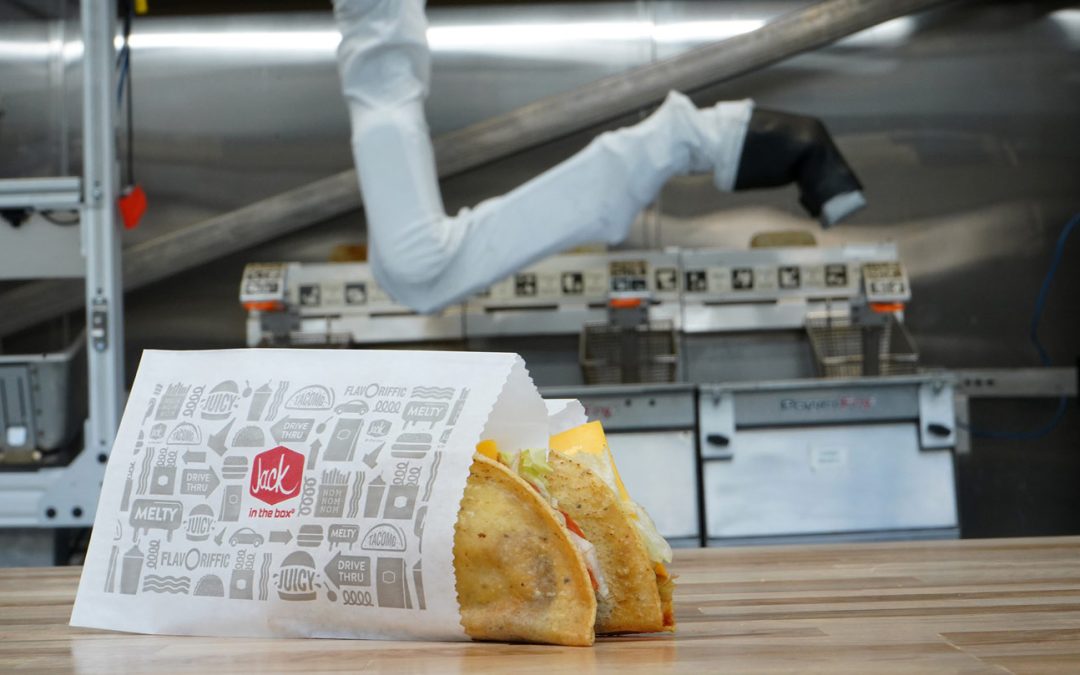Miso, best known for Flippy the burger-flipping and fry-frying robot, is coming to Jack in the Box. It’s the latest announcement in what Miso CEO Mike Bell calls a “drumbeat” of new pilots and partnerships. In the mix, Chipotle’s Chippy test, Panera’s test of Miso’s CookRight Coffee monitoring platform and most recently, Jack in the Box is testing the updated wall-mounted Flippy 2 and Sippy, Miso’s fountain-drink automation tool.
White Castle was the first major brand to commit to a big push, the company announced it would roll out 100 Flippy installations across the country. It seems like it’s the first of many, with so many major national brands now taking full automation seriously.
Bell said his voicemail box is full and his email is overwhelming.
“Truthfully, it’s all inbound. You would not believe the number of people saying, ‘Hey, can you help me with this,'” said Bell. “The answer is usually, yes we can, but not now. For us, it’s solving the biggest problems the soonest.”
That means there has to be as much scale as possible. Building a robotic solution or fitting a Flippy installation into an existing brand means a lot of work and teams of engineers, efficiency studies and a lot of testing. The international QSR category is a logical place to find an environment of incredible scale with all sorts of routine tasks.
“We usually send a team in, a couple people, to observe their operation and understand their key metrics,” said Bell. “Every QSR is different, some are extremely different. We look at it and say this is where we think we can help. Some are easier than others, some have really big menus that do all kinds of things from chicken on bone to frozen stuff. Some are easier than others to hit a ROI. We send that survey team in and get them an ROI and some basic math.”
Jack in the Box, which just announced it would be partnering with Miso at a San Diego, California, location is a great example of the scale Bell and Miso look to attack.
“They are a classic fit for us, they have such a diverse menu of fried items, not just fries—but things like tacos, their No. 1 fried item,” said Bell. “We created a couple new functions that are just for them. Flippy 2 is 80 percent consistent, then there’s a 20 percent customization process for brands. We created these specialty baskets that allows Flippy to grab the tacos.”
Tacos, unlike fries, don’t float when they cook. So those custom baskets keep the tacos in place and allow Flippy to take over most of the activity. It saves some part of that labor, to be sure, but Bell said the conversation is less about replacing workers than just staying open, even though that’s how many brands start thinking about automation in the first place.
“We’ve been able to change the topic of discussion. Everyone came in and got to know us talking about minimum wages. Today, it’s, ‘We can’t open stores because we don’t have the headcount. That’s the initial get-to-know-you call. But the value proposition has completely changed. We say this is not a labor-cost savings, it’s a revenue boost,” said Bell. “Certain brands are very quant [finance] focused and they understand the redistribution of labor, they’re deep on it. When you free up 50 to 100 percent of a station, they quickly know where that body can go next.”
Something like Panera’s use of the CookRight system means no more physical checks of the coffee cart [something this editor dreaded when he worked at Panera so many years ago]. That is labor savings, but that employee can now check the data while making an espresso drink or prepping bagels, meaning more revenue-producing time out of that employee.
The set of automation leaders are pretty close to the bleeding edge, but these tests show that the results from pioneers out there are pretty encouraging. Looking across the landscape, it’s a “mixed bag” of adoption driven largely by forward-thinking people in the corporate office.
Who would have bet White Castle, the oldest fast-food brand, would get ahead of techno-salad maker Sweetgreen? The latter acquired kitchen automation startup Spyce for $50 million last August, but has yet to announce plans for the technology.
Miso Robotics is primarily funded by individual investors and is one of the most successful crowdfund stories in history, as we’ve covered previously. The company has raised more than $50 million in crowdfunding to date and is currently in their Series E round, which kicked off with a market valuation of $500 million.
Take a look at the robot in action at Jack in the Box below:


